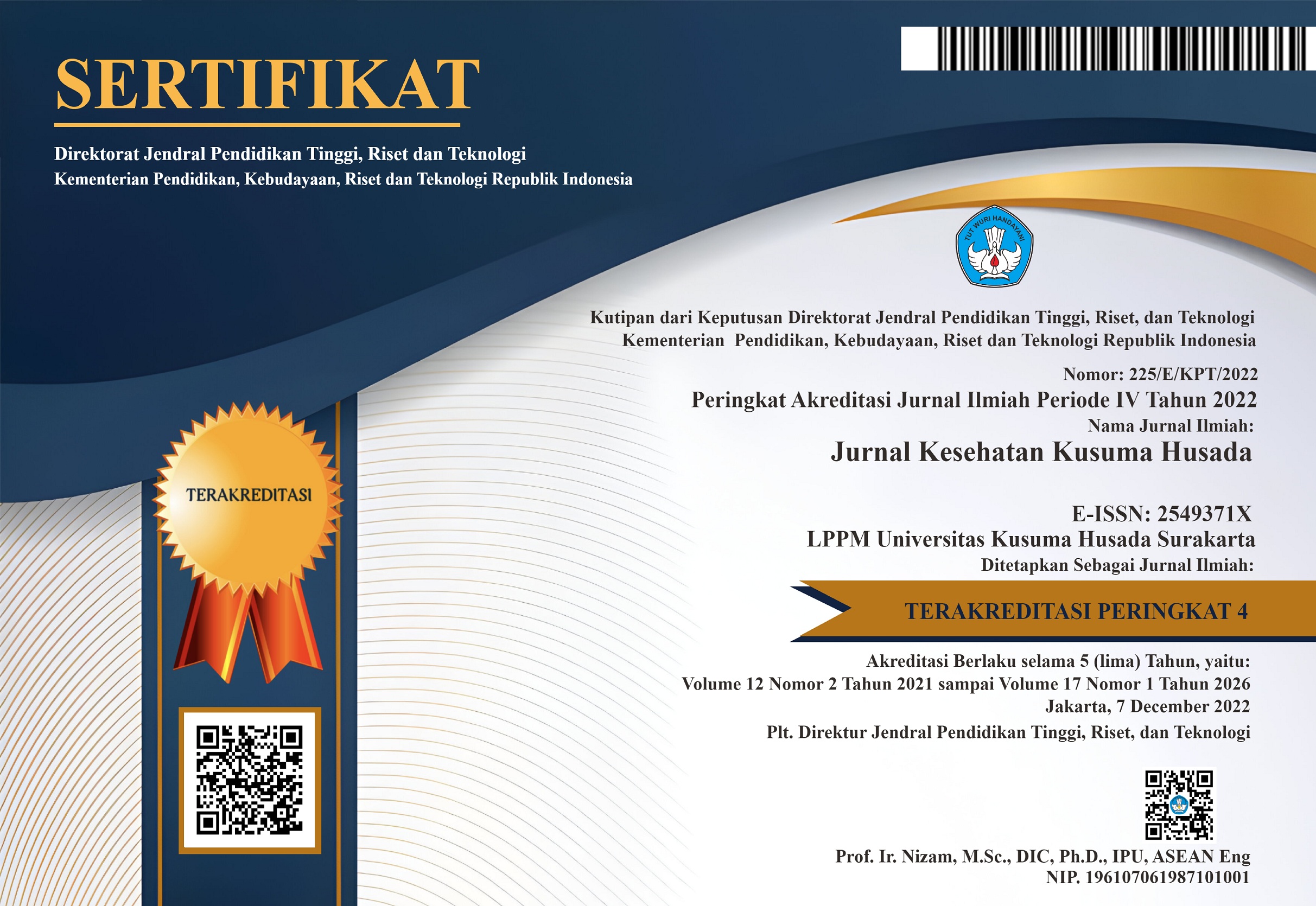PENGARUH PEMASANGAN NIV (NON INVASIVE VENTILATION) DAN HFNC (HIGH FLOW NASAL CANNULA) TERHADAP FREKUENSI NAFAS DAN SATURASI OKSIGEN PADA PASIEN HAPPY HIPOXIA TERKONFIRMASI COVID-19
DOI:
https://doi.org/10.34035/jk.v14i2.1091Keywords:
Covid 19, HFNC, NIV, Frekuensi Nafas, Saturasi Oksigen, Respiratory Frequency, Oxygen SaturationAbstract
Penggunaan NIV pada pasien gagal napas pada 3 jam pertama lebih efektif dalam memperbaiki klinis respirasi, kadar pCO2 dan rasio PaO2/FiO2 dibanding penggunaan ventilasi mekanik dengan intubasi. HFNC dapat memberikan campuran udara dan oksigen dengan FiO2 tinggi yang dipanaskan dan dilembabkan secara memadai dengan laju aliran 30 - 60 L / menit, dan dianggap memiliki sejumlah manfaat fisiologis. Penelitian ini bertujuan umtuk mengetahui pengaruh pemasangan NIV (Non Invasive Ventilation) dan HFNC (High Flow Nasal Cannula) terhadap frekuensi nafas dan saturasi oksigen pada pasien happy hipoxia terkonfirmasi Covid-19. Metode penelitian ini menggunakan rancangan Quasy Experiment dengan bentuk Pre Post Test. Penelitian ini menilai frekuensi nafas dan saturasi oksigen sebelum dan sesudah pemasangan NIV dan HFNC. Teknik sampling dengan menggunakan purposive sampling sebanyak 172 responden. Pengaruh pemasangan NIV dan HFNC terhadap frekuensi nafas dan saturasi oksigen pada pasien happy hipoksia terkonfirmasi covid-19 dilakukan uji uji Wilcoxon. Hasil analisa Uji Wilcoxon menunjukkan bahwa ada pengaruh pemasangan NIV (Non Invasive Ventilation) dan HFNC (High Flow Nasal Cannula) terhadap Frekuensi Nafas (p value 0,000) dan saturasi oksigen (p value 0,000) pada pasien happy hipoxia terkonfirmasi Covid-19 . Kesimpulan pada penelitian ini asalah ada pengaruh pemasangan NIV (Non Invasive Ventilation) dan HFNC (High Flow Nasal Cannula) terhadap frekuensi nafas dan saturasi oksigen pada pasien happy hipoxia terkonfirmasi Covid-19.
The use of NIV in patients with respiratory failure in the first 3 hours is more effective in improving clinical respiration, pCO2 levels and PaO2/FiO2 ratios compared to the use of mechanical ventilation with intubation. HFNC can provide adequately heated and humidified high FiO2 air and oxygen mixtures at flow rates of 30 – 60 L/min, and is thought to have a number of physiological benefits. This study aims to determine the effect of NIV (Non Invasive Ventilation) and HFNC (High Flow Nasal Cannula) installations on respiratory frequency and oxygen saturation in happy hypoxic patients confirmed with Covid-19. This research method uses the Quasy Experiment design with the Pre Post Test form. This study assessed respiratory rate and oxygen saturation before and after NIV and HFNC installation. The sampling technique used purposive sampling of 172 respondents. The effect of NIV and HFNC installation on respiratory frequency and oxygen saturation in happy hypoxic patients confirmed by Covid-19 was carried out by the Wilcoxon test. The results of the Wilcoxon Test analysis showed that there was an effect of NIV (Non Invasive Ventilation) and HFNC (High Flow Nasal Cannula) installation on Respiratory Frequency (p value 0.000) and oxygen saturation (p value 0.000) in happy hypoxic patients confirmed with Covid-19. The conclusion in this study is that there is an effect of NIV (Non Invasive Ventilation) and HFNC (High Flow Nasal Cannula) installation on respiratory frequency and oxygen saturation in happy hypoxic patients confirmed with Covid-19.
References
Downloads
Published
Issue
Section
License
Copyright (c) 2023 Jurnal Kesehatan Kusuma Husada

This work is licensed under a Creative Commons Attribution 4.0 International License.
The copyright of the published articles belongs to Jurnal Kesehatan Kusuma Husada.

This work is licensed under a Creative Commons Attribution 4.0 International License.
















